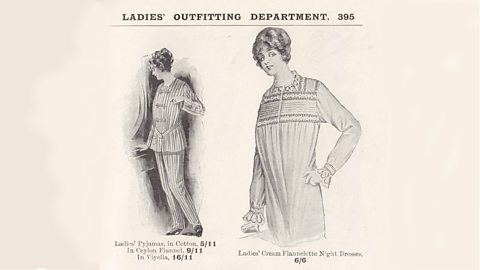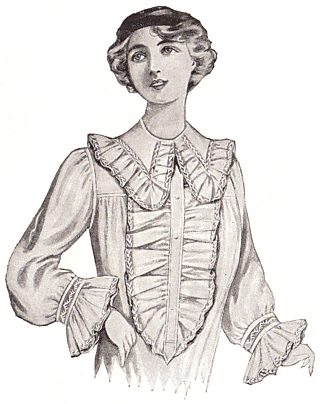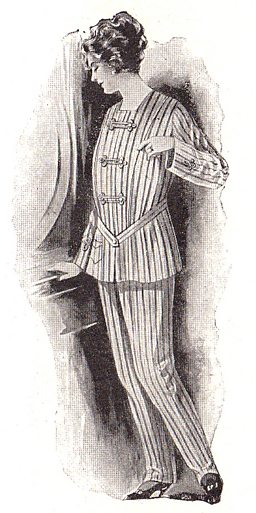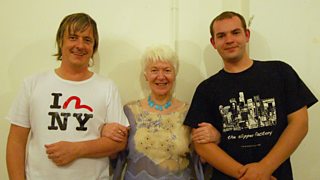‘World War Onesie’ — how night-time air raids started a revolution in the type of clothing women wore to bed
29 May 2018
In the 21st Century, we’re well used to seeing people wearing pyjamas when doing their shopping or the school run, but back in the early 1900s it was practically unheard of for a woman to wear PJs at all — even in the bedroom.
It took the Zeppelin air raids across parts of First World War Britain to prompt the marketing of pyjamas to women, as explained in the BBC Radio Scotland series Time Travels:-

Scotland, dressing for an air raid, pyjamas
The Great War was the first time it became acceptable for women to wear pyjamas to bed.
Promoting pyjamas to women
Lucie Whitmore, a PhD Researcher at University of Glasgow, described “the huge change in lifestyle” that surrounded events of World War One and was responsible for changes in women’s fashion.

Would it not be better to run out and look at the zeppelin in a pair of tasteful blue pyjamas and a pair of scarlet, Turkish slippers?Manchester Guardian, October 1915
“Before the turn of the 20th Century, both men and women would have quite often worn nightgowns, so even pyjamas for men were relatively new around 1900.”
Zeppelin air raids began in 1915, meaning women and children could suddenly become victims of war in their own beds.
“Magazines started suggesting that women should either wear more practical nightwear – should they have to run from their beds in the middle of the night – or nightwear that really made them look presentable should they bump into their neighbours [out on the street] at 3am.”
“Civilian armour”
Pyjamas were warmer and practical; their pockets were useful for storing things necessary in an emergency.
Another recommended garment was the sleeping suit – essentially a “First World War onesie” – which was also comfortable, practical and warm.
One St Andrews newspaper article reported that, prior to the war, women would have been thought of as “extraordinary freaks” if they wore pyjamas.
Although Lucie “doesn’t 100% agree” with the way these items of clothing were marketed, she explained that, by 1918, about a third of all women were wearing pyjamas to bed — demonstrating that the popularity of “slightly useless, civilian armour” had really taken off.

Women’s roles in World War One
The First World War also saw a massive shift in the roles of women within British society.
The absence of large numbers of young men resulted in women setting aside traditional expectations and instead taking on the sorts of roles required to keep the country running.
Latest features from BBC Scotland
-
![]()
'Wild swimming helps me process the grief of losing my son'
The benefits of cold water therapy.
-
![]()
Winter adventures are appealing, but an expert advises caution
Trips in winter require particular knowledge and skills.
-
![]()
The rescuers: Why volunteers risk their lives in mountain emergencies
Landward meets members of the Cairngorm Mountain Rescue Team.
-
![]()
‘Look for the light’ – practical tips to help you through another winter with SAD
Useful advice and tips to combat low moods at this time of year.
-
![]()
How you could be a binge drinker without even knowing
Binge drinking is classed as fewer units than many people may realise.
-
![]()
How chocolate biscuits and drama classes helped one man leave prison behind
The healing power of creativity.
-
![]()
'When people believe in you, it’s life-changing'
Author Graeme Armstrong revisits the man who helped turn his life around.
-
![]()
The 'breath-taking' display of US birds swept on to British soil
Recent storms have brought rare birds to our shores.
-
![]()
Six things we learned about Alan Cumming on Take the Floor (Spoiler: includes accordions)
The actor spoke to Take the Floor's Gary Innes.
-
![]()
How street gangs trap young men in a dangerous cycle of violence
The almost inescapable pull of life in a gang.
-
![]()
Why stylist Gok Wan believes there's no such thing as bad fashion
The fashion expert says we should stop following rules and do what feels right.
-
![]()
Is sending a CV still the right way to apply for a job?
They've been central to job applications for years, but are they worth it?



















